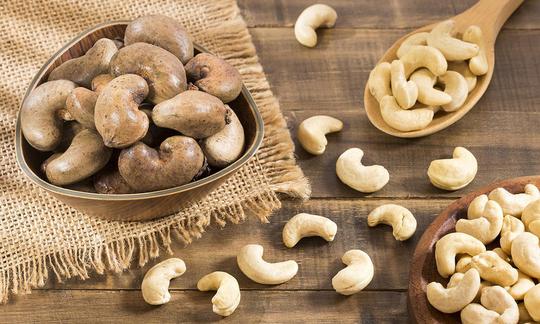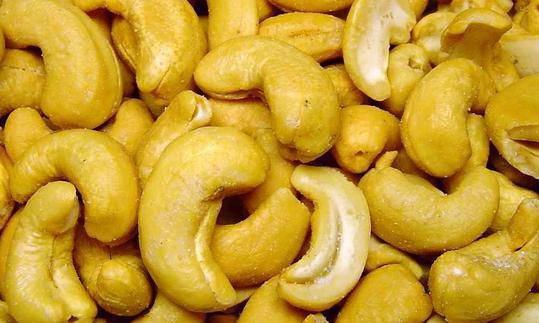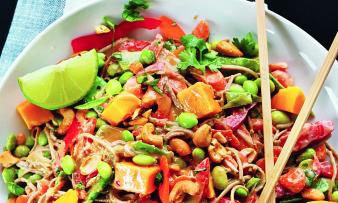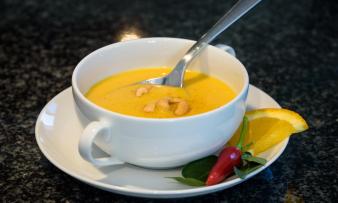The cashew nut , also known as cashew kernel or cashew fruit, is practically never available "raw". You can find out more under Cashew nut, "raw" . The poisonous oil contained in the double shell can only be deactivated with heat.
Use in the kitchen:
Roasted , unsalted cashew nuts taste great as a snack, in muesli or to enhance any mixed salad. They go well with vegetable dishes, but also go well with rice. Cashew puree can be used to thicken sauces, refine spreads or make vegan cheese. Cashew nuts are also often found as an ingredient in desserts. Their sweet, nutty taste is very tempting and often leads to excessive consumption, especially in vegan diets. Please use cashew nuts rarely and if you do, then make sure they are of good quality. You can read the background to this in the text of the following link.
| Not only vegans or vegetarians should read this: Vegans often eat unhealthily. Avoidable nutritional mistakes . |
Purchasing:
Cashew nuts are available in stores roasted, unsalted, salted or seasoned. The term "raw" is often used, but this only indicates that the nuts are produced more gently (e.g. with steam). If the cashew nuts have dark spots or are broken, this means that they are of poor quality. When buying shelled nuts, look for white, whole kernels, preferably from organic production.
Production:
In conventional roasting processes, pans with oil are used over an open fire. Modern production, however, mostly works with a dry roasting process. The raw cashew nuts are roasted dry in the oven with their shells on. This means that the cashews are roasted without fat, which means that the natural taste is retained. Roasting takes place at around 200 °C, which simultaneously deactivates the toxic shell oil.
Roasting makes the shell brittle. The roasting process must be carefully controlled to ensure that the cashews do not become too dark in color.
Cracking requires a lot of skill and is done partly by hand or with the help of a device - a kind of foot-operated nutcracker. The shelled cashews are then dried again in heated ovens. The seeds are still surrounded by a thin skin (testa), which can be removed with a knife.
The white kernel must not be damaged, as the oil contained in it can penetrate the seed. The workers often carry out this work without gloves: on the one hand, they have to pay for them themselves, and on the other, the rubber dissolves anyway due to the caustic oil. The hands are therefore only protected with oil, clay, wood or potash. The latter helps protect against the shell oil, but dries out the hands considerably. This causes the skin to crack and is in turn more vulnerable to the strong acid in the shell oil.
Often the fingertips are erased as a result of this work. This fact renders many workers incapable of doing business, as illiterate people in particular seal their deals with their fingerprints. In Sri Lanka there are traditional methods where workers open raw cashew nuts with the help of a hammer. Although the workers wear gloves and firewood ash to protect themselves from the caustic oil, this process is extremely dangerous.
In order to remove the thin, dark skin (testa) on the nuts after opening and extracting them from the shell, they must be dried. Traditionally, this is done over an open fire in a pan at around 55 to 60 °C. You can find more information about the production process in the video The production of cashew nuts .
Storage:
Cashew nuts must be sealed airtight after the peeling process, as aflatoxins can easily form if stored incorrectly. Opened packages should be stored in a dry place and consumed immediately.
Ingredients:
Cashew nuts are very high in calories, especially the fat and carbohydrate content. At 15%, the protein content of cashew nuts is very high for a plant-based protein source and they are just behind the protein-rich legumes. This plant-based protein contains a lot of the essential amino acid L- tryptophan . The body uses it to produce the neurotransmitter, the "happiness hormone", serotonin. Cashew nuts also have a very high content of B vitamins. They contain: Vitamin B 1 , B 2 , B 5 , B 6 . Also vitamin E and vitamin K and important minerals such as magnesium and iron .
Unfortunately, cashew nuts contain a lot of omega-6 fatty acids ( linoleic acid , LA, 7.8 g/100g) and very few omega-3 fatty acids ( alpha-linolenic acid , ALA). This is in the "raw" quality. The ratio of LA to ALA is therefore at least 48:1 and up to 130:1. In a western diet, the ratio is usually 10:1 instead of the desired 2:1, and health authorities are trying to bring the value down to 5:1. Vegans and vegetarians - largely because of the popularity of cashew nuts - show a ratio of 17:1 to 24:1, which promotes all kinds of inflammatory processes in the long term. The receptors for the inflammation-causing LA and the anti-inflammatory ALA are the same.
I can only warn: vegans and vegetarians who are misinformed or uninformed generally live worse than normal eaters - and a study is sure to come out that will ruthlessly expose this (see link in the box above). This would then stop the vegan hype that is so important for animal welfare and the environment and discredit the oriented minority. This has been our fear since 2014! See this link to see what happened with raw food (The Giessen Raw Food Study) .
Health aspects:
The L-tryptophan contained in it can have a stabilizing effect on depression because it lifts the mood and calms it down. The B vitamins are considered to strengthen the nerves and support this.
Folk medicine:
Traditionally, infusions made from the bark and leaves of the cashew tree are used to treat toothache, a paste made from the bark acts as a vermifuge and ingredients from the root serve as a laxative. The caustic shell oil is used in tropical areas to treat warts and corns. The anacardic acid in the shell oil helps with tropical diseases such as leprosy, elephantiasis (abnormally enlarged body parts caused by lymphatic congestion) and psoriasis (inflammatory skin disease).
Dangers / Intolerances:
Cashew nut shell oil (CNSL = Cashew Nut Shell Liquid) contains around 20% toxic oil. This oil consists of around 70-80% anacardic acid, 4-20% cardol, 1-9% cardanol and 1-4% 2-methylcardol. 5 Anacardic acid, which predominates here, takes its name from the botanical name of the cashew tree Anacardium. It is a phenolic substance that is related to urushiols, the oil-like chemical compounds found in poison ivy.
In its original form, this shell oil is highly toxic and causes severe burns to the skin and mucous membranes. If it penetrates the body, it causes nerve damage, impairs the ability to react and triggers metabolic diseases. The toxic oil can be rendered harmless by heating it in the shell, but this produces very toxic fumes that are very irritating to the respiratory tract. Some people are allergic to cashews, but this allergy is much rarer than to other types of nuts.
Occurrence:
The cashew tree originates from Brazil, but in the 16th century it was brought to India by the Portuguese and later to practically all of today's tropical growing areas. Since the 19th century it has been grown on plantations in Africa, Asia and Latin America. Vietnam, Nigeria, India and the Ivory Coast have been the largest producers since 2016. Smaller countries such as Benin and Guinea-Bissau have also caught up in the production of cashew nuts. 6
The government of Guinea-Bissau, for example, promoted the cultivation of cashew trees as cash crops. They encouraged farmers to plant cashew trees and set minimum prices. The workers could use the proceeds to buy rice, their important staple food. However, in 2006, world market prices fell so low that Indian wholesalers no longer bought the cashews or only bought them at very reduced prices. This led to severe famine in the regions. 7
This is just one example of how it can work. In other countries, cashew cultivation is an opportunity for small businesses and residents to create jobs in the regions and counteract rural exodus. This work is mainly carried out by women and child labour cannot often be ruled out, unfortunately often under the most adverse and unhealthy working conditions.
Cultivation, harvest:
When the cashew fruits are ripe, they fall to the ground. Unfortunately, the fruit stalk is very sensitive to pressure and cannot be stored. If you want to use the cashew apples, you have to process them immediately into cashew juice, jam or liquor, for example. However, the fruits are often harvested unripe directly from the tree, which means that the fruit stalk cannot be used and the quality of the seeds is also inferior.
General information:
The evergreen cashew tree ( Anacardium occidentale ) belongs to the sumac family. The so-called cashew apple is a yellow to orange-red pear-shaped false fruit. It does not have seeds inside, but the actual fruit of the tree, the cashew kernel (Portuguese: Caju), hangs down in a kidney shape from the thickened fruit stalk. The cashew kernel is sometimes called an "elephant louse". From a botanical point of view, cashew nuts are stone fruits. The rock-hard, wooden shell contains the cashew kernel we know, which is often mistakenly referred to as a nut. It is, however, a seed.
Cashew nut shell liquid (CNSL) is particularly important for the industry. It is a viscous and dark liquid. The CNSL is located between the soft outer skin of the nut and the harder inner shell. It is a natural oil with high heat resistance. When exposed to heat, the ingredient anacardic acid turns into cardol and cardanol, which also have a corrosive effect. These phenolic compounds are needed in this form for industry. The shell oil is used to produce synthetic resins, lubricants, dyes and preservatives. The main markets for this shell oil are the USA, the EU (mainly the UK), Japan and South Korea. 3,6
The oil is extracted by heating the nuts. It is often used for roasting the cashews or sold to industry. It also works against termites and mosquito larvae. Studies in pharmaceutical biology describe the antibacterial properties of cashew shell oil against various gram-positive bacteria. 4 After the cashew shell oil has been extracted, the nutshells are burned to fuel the roasting process or they are sold on. 6,8
The thin skin that surrounds the core can also be reused. The testa is mainly used as animal feed or to make leather. 8
The trunk of the cashew tree contains rubber (cashew or acajou rubber), which is also of interest to industry.
The largest cashew tree in the world is in Brazil. It is mentioned in the Guinness Book of Records. This specimen, with a circumference of 500 m, has a genetic anomaly: its branches do not grow upwards, but to the side and form new roots when they touch the ground. Around 2.5 tons of cashew fruits are harvested from this tree every year.
Literature / Sources:
- German Wikipedia: Cashew.
- utopia.de Cashew nuts - what you should know about cashews.
- Tullo A H. A Nutty Chemical. Naturally occurring phenol compounds in cashew shells are becoming increasingly useful to industry. American Chemical Society. Sept.2008;86(36). doi: 10.1021/cen-v086n036.p026.
- Bouttier S, Fourniat J, Garofalo C, Gleye C, Laurens A, Hocquemiller R. ß-Lactamase Inhibitors from Anacardium occidentale . Pharmaceutical Biology. 2002;40(3). doi: 10.1076/phbi.40.3.231.5827
- Türk O. (2013) Material use of renewable raw materials. Polymers from phenolic monomers. Springer Vieweg, Wiesbaden.
- Azam-Ali SH, Judge EC. Small scale cashew nut processing. Food and Agriculture Organization of the United Nations. 2001.
- Faget J. Fight for survival. Monoculture drives inhabitants of Guinea-Bissau into hunger. Deutschlandfunk. Sept. 2006.
- International Finance Corporation IFC. Prospects of Cambodia’s Cashew Sub-Sector. 2010.













Comments